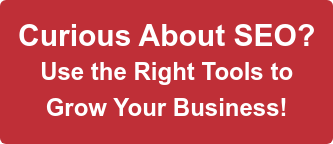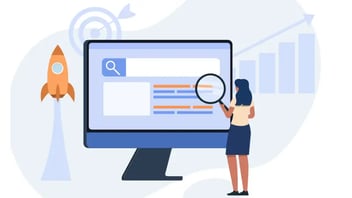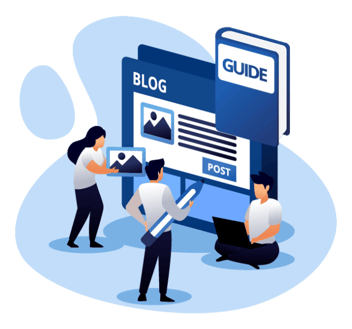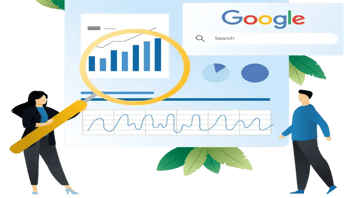How AI Is Changing the Way SEO and Content Work Together
When it comes to modern SEO approaches, search engines have basically thrown out the playbook. Everything that got you ranked even 24 months ago? Gone. Whether it was legitimate optimization and research, or keyword cramming, cookie-cutter blog posts, those tired optimization "hacks"—none of it works anymore.
Currently, businesses competing for visibility are learning the hard way that AI and SEO have evolved into something entirely new. This isn't about marginal gains; it's a total rethinking of how content is created and how it climbs the rankings. In fact, reports show that 67% of people experience improved content quality after incorporating AI tools into their creation process. The use of AI in marketing is changing everything.
The Evolution of AI and SEO Integration
What does artificial intelligence in SEO look like today versus what traditional optimization used to be? It's like night and day. We are now watching algorithms actually learn your audience, adjust on the fly, and predict what users want before they finish typing.
From Manual to Intelligent
Think back to when SEO was literally just counting how many times you said "best pizza in Chicago" on a page. Remember link farms? That's ancient history now. Artificial intelligence has taken over how we search and how our queries are assessed and answered.
Monumental updates from Google drove this shift:
-
BERT (Bidirectional Encoder Representations from Transformers): Introduced in 2019, BERT marked the first step toward genuine understanding. It allowed Google to process the full context of a word in a query, not just the words themselves. For example, in the query "how to start a business in Toronto," BERT understands that "in" is critical to the meaning, rather than just matching documents containing "start a business" and "Toronto" separately.
-
MUM (Multitask Unified Model): Building on BERT, MUM is designed to understand information across multiple languages and formats (text, images, video) and answer complex questions that previously required multiple searches. It helps Google pick up on nuance and figure out what someone is really asking for, serving up answers that actually help.
This transformation occurred much faster than anyone had predicted. The goal is no longer to trick the algorithm; it's to align with Google's relentless pursuit of helpful and authoritative content.
Work for Your Content Strategy
Understanding the tech is step one. Actually making it produce results for your business is where most people stumble. The question stopped being "should we use AI?" a while ago. Now it's all about execution.
AI-powered content creation platforms aren't optional anymore if you're trying to maintain any kind of publishing velocity. No matter how convenient these systems become, the real value still lies in genuine, well-written human content. The goal is to marry AI efficiency with human expertise.
Core Areas Where AI in SEO Transforms Strategy
Three zones are currently showing the biggest returns. Here's where your investment actually pays off.
1. Keyword Research Revolution
Modern AI doesn't hunt for keywords; it predicts which ones will take off next quarter.
-
Semantic Clustering: This happens automatically, grouping related concepts without requiring any manual intervention. Instead of targeting 20 different keywords, the AI identifies one overarching topic authority cluster (e.g., grouping "content marketing strategy," "blog post ideas," and "SEO guide" together). This enables your content to rank for a wide range of related queries.
-
Intent Decoding: Natural Language Processing (NLP) decodes what users actually mean versus what they type. The search engine recognizes if the user has Informational, Navigational, Commercial, or Transactional intent. AI tools help you match your content to that specific intent before you publish.
-
Gap Analysis: Platforms like MarketMuse and Frase dissect the top ten search results for any topic and point out exactly what gaps exist in your content. This eliminates guesswork and ensures your article is more comprehensive than your competitors'.
The predictive power here changes everything. You're no longer chasing trends; you're ahead of them.
2. Content Creation at Scale
Here's where it gets wild. AI-powered content creation systems can pump out blog articles, product copy, and social posts in the time it takes you to grab coffee.
But there's a catch, and it's important. Raw AI output needs human polish to actually connect with readers.
The winning formula for maximum ROI is: Let AI handle research and first drafts, then bring in experienced writers to inject personality and expertise.
-
AI's Strengths: Generating outlines, summarizing vast amounts of research, creating 10 different title variations, and structuring the first 1,000 words based on competitor analysis.
-
Human's Strengths: Injecting unique personal experience (E-E-A-T), providing proprietary case studies, ensuring the brand voice is authentic, and performing crucial quality control. Quality control isn't optional.
Case in Point: Companies leveraging AI push out 42% more content monthly compared to those still doing everything manually. That efficiency lets your team focus on big-picture strategy instead of repetitive grunt work.
3. Technical Automation
SEO automation tools have taken over the mind-numbing tasks that used to drain entire afternoons. This is often the quickest win for small teams.
-
Proactive Site Audits: Site audits now run automatically, flagging technical problems like broken links, indexing issues, and crawl errors before they tank your rankings.
-
Schema Markup Generation: Schema markup—the code that tells search engines what your content is (a recipe, a review, a how-to)—used to take forever. Now, it's generated instantly, making your content eligible for rich results, such as Featured Snippets.
-
Core Web Vitals Optimization: Tools now utilize machine learning to identify performance issues before they occur. For example, they can predict which heavy JavaScript files are most likely to slow down mobile loading times, helping you improve user experience metrics, such as Largest Contentful Paint (LCP).
AI in Content Marketing: Real-World Applications
Practical uses extend way past basic optimization tricks. We're witnessing fundamental shifts in how content finds its audience and actually resonates with them.
Personalization Power
Content that adapts in real-time to user behavior? It's happening now.
-
Dynamic Delivery: Two people visiting the same URL might see completely different versions, each tailored to what's most likely to convert them specifically.
-
Continuous A/B Testing: AI-driven A/B testing runs continuously, tweaking elements like headlines, images, and Call-to-Action buttons without requiring any manual intervention.
-
Hyper-Relevant Recommendations: Personalized recommendations appear based on browsing history, location, and previous clicks.
Performance Prediction
Maybe the most valuable capability is knowing your content ROI before publishing. This predictive intelligence eliminates guesswork from content budget decisions.
-
Engagement Forecasting: Prediction models analyze similar pieces of content and forecast what will perform well.
-
Strategic Scheduling: Publishing time recommendations take into account precisely when your specific audience is most active.
-
Lifespan Planning: Content lifespan projections help you schedule updates strategically, maximizing the value of your evergreen pieces.
You'll know what's worth producing before investing resources.
Building Your AI-Enhanced Workflow
Theory sounds great in articles. Implementation is what separates winners from everyone else. Here's how to effectively integrate these tools into your operations without disrupting everything.
Getting Started
-
Be Honest About Bottlenecks: Begin with brutal honesty about your current setup. What's producing results? What's eating time without payoff? Is your bottleneck research? Drafting? Technical audits?
-
Establish Meaningful KPIs: Define Key Performance Indicators (KPIs) that genuinely impact your bottom line, and discard vanity metrics.
-
Focus on: Time saved in production, ranking improvements for AI-optimized pages, engagement rates, and conversion lifts.
-
Forget: Total impressions or simple traffic numbers.
-
-
Start Small: Allocate your budget toward tools that address your biggest bottlenecks first. Trying to implement everything simultaneously is a recipe for chaos. Pilot programs consistently outperform big rollouts. Test one tool or workflow, track the results, and then expand based on the findings.
Measuring Results
Performance indicators for AI-enhanced SEO differ from traditional metrics.
-
Cost-Benefit Analysis: Needs to factor in both the software subscription costs and the hours saved by your team. For instance, if an AI tool costs $100/month but saves a $5,000/month writer 10 hours of research, your ROI is immediate.
-
Focus on Trends: Attribution becomes complicated with AI because multiple tools often work in tandem. Focus on overall performance trends rather than trying to attribute each tool's individual contribution.
Common Questions About AI and SEO Integration
How does Google treat AI-generated content for rankings?
Google doesn't specifically penalize AI content. They evaluate quality, relevance, and usefulness. AI-generated material that hits E-E-A-T standards (Experience, Expertise, Authoritativeness, Trustworthiness) and delivers genuine value ranks just fine. The critical piece is human oversight, ensuring accuracy and originality.
What's the realistic ROI timeline for implementing AI tools?
-
Initial Time Savings: Most organizations notice initial time savings within 2–3 weeks of setup.
-
Measurable Ranking Improvements: Usually surface after 2–3 months of consistent application.
-
Full ROI: Typically arrives around 6–9 months as teams master the tool's capabilities and refine their processes.
Can small businesses compete with larger enterprises that use these tools?
Absolutely, yes. Many AI platforms offer affordable starter plans designed specifically for smaller operations. The playing field has actually leveled because AI democratizes access to sophisticated analysis that previously required massive teams and budgets. Strategic focus beats big spending.
Final Thoughts
The merging of AI in content marketing with traditional SEO isn't slowing down; it's accelerating hard. Organizations investing in these technologies today are building advantages that compound month after month. 51% of companies planning to boost AI content spending aren't following a fad; they're adapting to reality.
Start with one tool, test relentlessly, and scale whatever produces results. The gap between businesses that use AI effectively and those that pretend it'll go away is widening every day. What's your next move?
Reach out to Aspiration Marketing to help.
This content is also available in:
- German: Wie KI die Zusammenarbeit von SEO und Inhalten verändert
- Spanish: Cómo la IA Revoluciona la Sinergia entre SEO y Creación de Contenido
- French: Comment l'IA révolutionne le référencement et la création de contenu
- Italian: L'IA Trasforma la SEO e la Creazione di Contenuti
- Romanian: Cum schimbă AI modul în care SEO și conținutul lucrează împreună
- Chinese: 人工智能如何改变搜索引擎优化和内容的合作方式

Opinions expressed in this article are those of the guest author. Aspiration Marketing neither confirms nor disputes any of the conclusions presented.









Leave a Comment